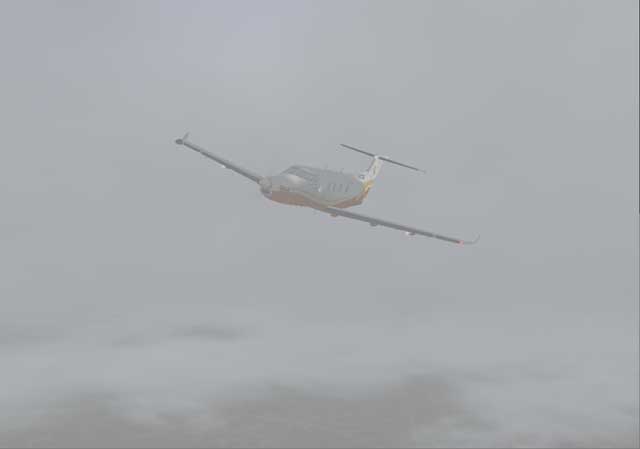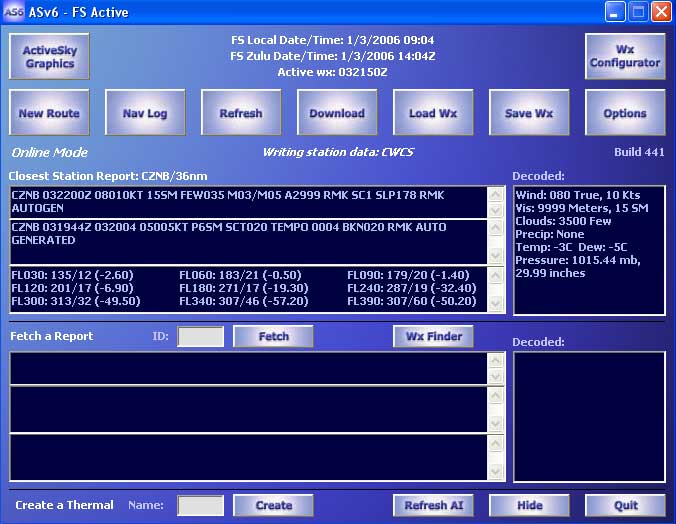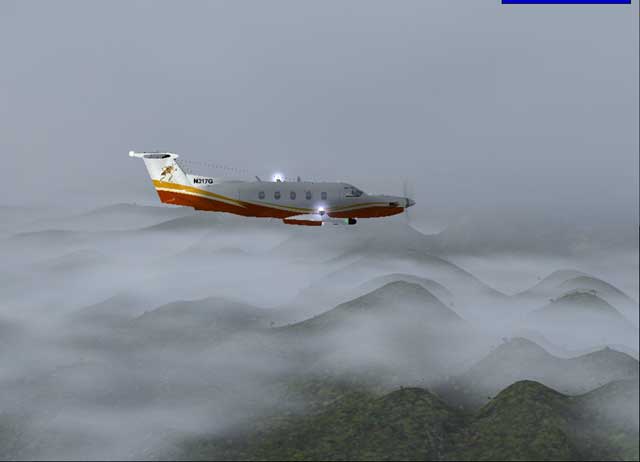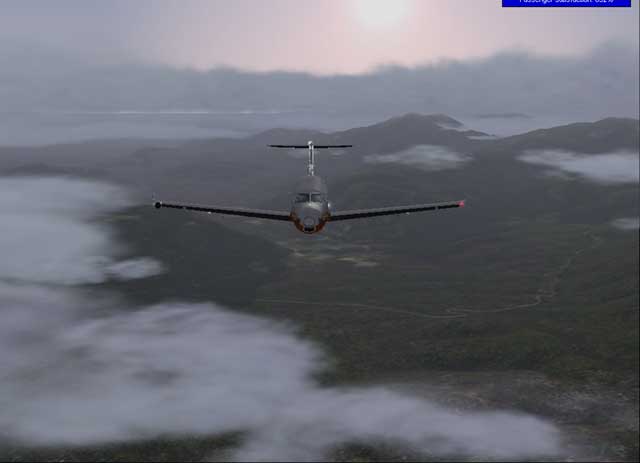Product
Review:
Active
Sky 6
HiFi
Simulations
By: George
Zhen
January 3, 2005 |
 |
I
was bummed a few weeks ago when the servers from Microsoft
that supply real-time weather information were down.
My copy of FS2004 locked up and it took some patience
and research to discover the problem wasn't in fact
on my end. It was also during this research that I ran
across the press release for Active Sky 6, the
latest real-time weather enhancement option from HiFI
Simulation Software.
 Conspiracy
theories aside (and trust me, I had a few), this product
claims to offer superior real-time weather coverage,
improved smoothing of transitions between weather regions
and more accurate weather information. So, I did what
any jaded sim user would do. Conspiracy
theories aside (and trust me, I had a few), this product
claims to offer superior real-time weather coverage,
improved smoothing of transitions between weather regions
and more accurate weather information. So, I did what
any jaded sim user would do.
I
plunked down the $37 and prayed that this investment
was worth it.
I
use several add-ons on my installation of FS2004, which
resides on a rather average system (AMD 2.4 GHz processor
with 512 RAM and a NVIDIA GForce FX5500 video card).
Among them are Ultimate Traffic and Flight Environment
from Flight1, FScene World Textures, and several meshes
from FS Genesis. I was particularly interested in how
AS6 would integrate with Flight1's Flight Environment
since both tackle visual enhancements to some degree.
But where Flight Environment tackles all aspects of
the visual environment (i.e., sky, moon, sun, water,
clouds and sky), AS6 only worries about the sky and
clouds. Both products live well together, and aside
for FE's propensity for overzealous lighting effects
in the name of stunning bedazzlement, the two are good
roommates on my copy of FS2004.
But
don't be confused. AS6's real purpose is to tackle the
weather gaps that MSFS doesn't fill. Things like updrafts,
wake turbulence and wind smoothing. How well does it
tackle such a challenge? Let's find out.
Installing
AS6 first requires that you have at least the latest
unregistered version of Peter
Dowson's FSUIPC program. HiFi Simulations has worked
out the licensing so that a version is included in the
product. Installing and configuring FSUIPC is no big
deal, but for those who are not manual readers, this
may be a problem since the FSUIPC install isn't a part
of the actual AS6 install process. That bit of necessary
awkwardness aside, the install is smooth and predictable.
Once
installed, the user will notice that AS6 has placed
two icons on the desktop. AS6 is actually made up of
two components, Active Sky Graphics (which is used to
configure cloud and sky types), and the Active Sky WX
Engine.
 AS
Graphics is a bare bones interface that gets the job
done simply and intuitively. The user will find that
there are several cloud and sky categories to select
a variety of cloud types from. Several types of cumulus,
cirrus and stratus clouds as well as skies ranging from
Arctic to Tropical in flavor. The choices here are so
vast that it can prove overwhelming at first, so there
are also Randomized and "WX Influenced" options
for the indecisive among us. It is also here in the
AS Graphics utility that users can decide what level
of detail they want their clouds to be displayed in.
Choices range from the high-impact 512X512 resolution
down to the framerate-friendly 64x64 variety. The lowest
rez offered by Flight1's Flight Environment is 128x128,
so this may be helpful to those with slower systems
easily bogged down by higher cloud resolutions. AS
Graphics is a bare bones interface that gets the job
done simply and intuitively. The user will find that
there are several cloud and sky categories to select
a variety of cloud types from. Several types of cumulus,
cirrus and stratus clouds as well as skies ranging from
Arctic to Tropical in flavor. The choices here are so
vast that it can prove overwhelming at first, so there
are also Randomized and "WX Influenced" options
for the indecisive among us. It is also here in the
AS Graphics utility that users can decide what level
of detail they want their clouds to be displayed in.
Choices range from the high-impact 512X512 resolution
down to the framerate-friendly 64x64 variety. The lowest
rez offered by Flight1's Flight Environment is 128x128,
so this may be helpful to those with slower systems
easily bogged down by higher cloud resolutions.
Once
the skies are chosen, AS Graphics then writes the appropriate
graphics to FS2004. Since it doesn't touch elements
like water and sunsets, using AS6 in conjunction with
Flight1's Flight Environment is no big deal, but do
keep in mind that FE does write over clouds and skies
when it updates FS2004's graphics. The user will have
to run AS Graphics after running Flight Environment
if they want the clouds and skies provided by AS6 to
appear.
 After
the graphics are configured, the next step in the process
is to set up the AS6 Weather Engine. There are several
options available in the Weather Engine, most concerned
with preventing the unexpected changes in weather that
create "popping" or sudden redraws in the
weather as weather regions are crossed or updates arrive
from the weather server. AS6 accomplishes this by creating
a buffer called "weather suppression" which
prevents weather from being updated within a certain
specified area around the aircraft and/or destination
airport. The user can specify that weather isn't updated
within a certain radius of the aircraft, or when below
a specified altitude. This is designed so as to prevent
those annoying drastic weather changes that pop in during
approach. There are many options here, limited only
by imagination, but it is highly recommended that the
user take the time to go through these setup options
one by one in the accompaniment of the fine user manual
included with Active Sky. The options are many and certain
systems may be impacted more than others based on what
is chosen. After
the graphics are configured, the next step in the process
is to set up the AS6 Weather Engine. There are several
options available in the Weather Engine, most concerned
with preventing the unexpected changes in weather that
create "popping" or sudden redraws in the
weather as weather regions are crossed or updates arrive
from the weather server. AS6 accomplishes this by creating
a buffer called "weather suppression" which
prevents weather from being updated within a certain
specified area around the aircraft and/or destination
airport. The user can specify that weather isn't updated
within a certain radius of the aircraft, or when below
a specified altitude. This is designed so as to prevent
those annoying drastic weather changes that pop in during
approach. There are many options here, limited only
by imagination, but it is highly recommended that the
user take the time to go through these setup options
one by one in the accompaniment of the fine user manual
included with Active Sky. The options are many and certain
systems may be impacted more than others based on what
is chosen.
Once
all of this configuration is in place, the only thing
left to do is use the thing. The process, in case you
are wondering, is to run the AS6 WX Engine and FS2004
together; two separate apps linked together via FSUIPC.
In my case, I launch FS2004, load a flight plan and
set myself up on the tarmac at my favorite airport.
I then ALT+Tab out of FS2004 to the desktop and enter
the AS6 WX Engine. When started, AS6 goes out and fetches
the weather for the world and passes it through to FS2004.
The resolution of the weather areas can be improved
here as well by entering your flight plan (in .PLN format)
into the WX Engine. By doing this, AS6 can go out and
fetch even MORE weather reports that pepper your flight
plan, enhancing the weather experience even more. This
is especially nice if flying transoceanic routes, as
this enhanced weather information means that the user
will actually find something interesting between KSFO
and PHNL.
 The
visual results of all of this is stunningly real, to
say the least. The multiple cloud layering, the use
of cirrus clouds down low to simulate creeping fog,
multiple stratus layers creating true overcast - all
a marked improvement over the standard fair offered
by MS or Flight1. That stupid, unrealistic default hazing
effect is gone, replaced by a convincing synthesis of
low-lying cirrus clouds. More playful turbulence, nasty
updrafts over terrain and downdrafts on TS approaches
make for some white knuckles in this AS6 enhanced world. The
visual results of all of this is stunningly real, to
say the least. The multiple cloud layering, the use
of cirrus clouds down low to simulate creeping fog,
multiple stratus layers creating true overcast - all
a marked improvement over the standard fair offered
by MS or Flight1. That stupid, unrealistic default hazing
effect is gone, replaced by a convincing synthesis of
low-lying cirrus clouds. More playful turbulence, nasty
updrafts over terrain and downdrafts on TS approaches
make for some white knuckles in this AS6 enhanced world.
To
help navigate through the nastiest of weather, AS6 also
comes with a weather radar unit that is integrated into
any aircraft by simply pressing CTL+F12. Although there
are other radar systems out there that are more feature-filled,
I found the AS6 version to be streamlined very nicely.
It's a low-impact addition that most systems can handle
without much concern for framerate.
 Additional
features in AS6 include the ability to pull up archived
weather data from as far back as December of 2003. This
can be useful for cases where a virtual pilot in the
States wants to fly in daytime Europe, but the current
weather pull would be for night time conditions due
to time differences. Another cool feature is the "Find
Weather" component which allows users to find specific
current conditions, such as rain or snow, anywhere in
the world. Additional
features in AS6 include the ability to pull up archived
weather data from as far back as December of 2003. This
can be useful for cases where a virtual pilot in the
States wants to fly in daytime Europe, but the current
weather pull would be for night time conditions due
to time differences. Another cool feature is the "Find
Weather" component which allows users to find specific
current conditions, such as rain or snow, anywhere in
the world.
So,
I guess the only question left is whether AS6 is worth
it. Hands down, the answer is yes. I never imagined
that FS2004 could be so drastically improved by one
app. It makes flying around the world an even greater
adventure knowing that the weather, both visually and
invisibly, is so greatly enhanced. Approaches are more
challenging, flight planning more vital and relative
than ever. Simply put, AS6 brings with it the greatest
positive impact a single application can have on Microsoft
Flight Simulator.
For more information on
Active
Sky 6, visit the HiFi Simulation website
at www.hifisim.com
|



![]()
![]()
![]()
![]()
![]()
![]()
![]()
![]()
![]()
![]()
![]()
![]()
![]()
![]()
![]()
![]()
![]()
![]()
![]()
![]()
![]()







